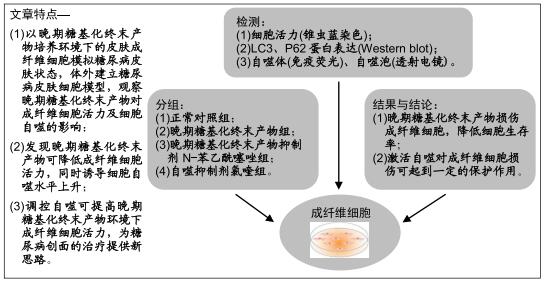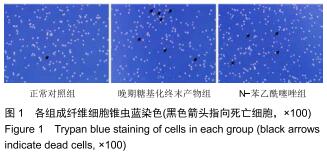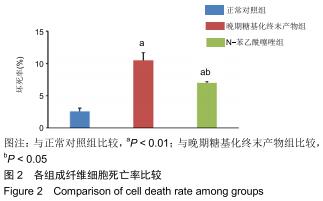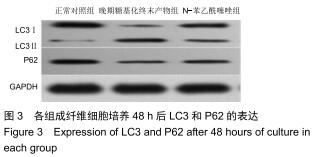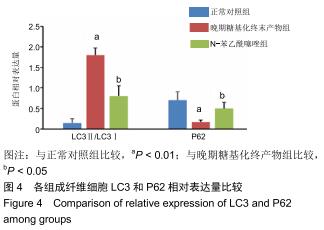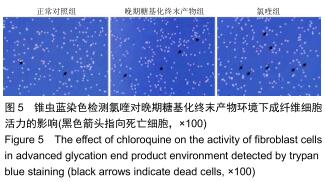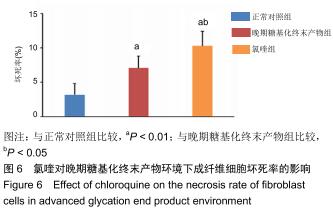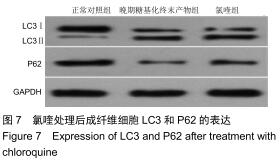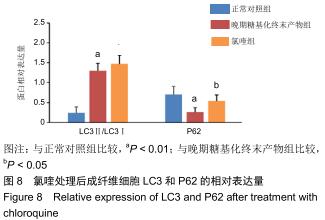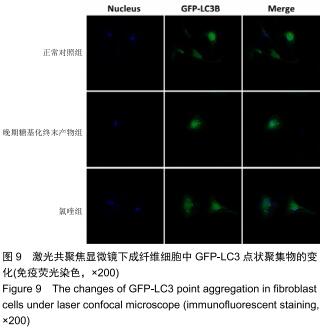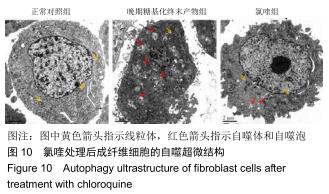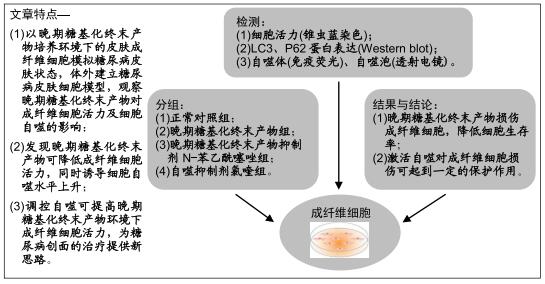|
[1] AJITH TA, VINODKUMAR P. Advanced Glycation End Products: Association with the Pathogenesis of Diseases and the Current Therapeutic Advances. Curr Clin Pharmacol. 2016;11(2):118-127.
[2] 陆树良,青春,谢挺,等.糖尿病皮肤“隐性损害”的机制研究[J].中华创伤杂志,2004,20(8):468-473.
[3] VERMA N, MANNA SK. Advanced Glycation End Products (AGE) Potently Induce Autophagy through Activation of RAF Protein Kinase and Nuclear Factor κB (NF-κB). J Biol Chem. 2016;291(3): 1481-1491.
[4] YU Y, WANG L, DELGUSTE F, et al. Advanced glycation end products receptor RAGE controls myocardial dysfunction and oxidative stress in high-fat fed mice by sustaining mitochondrial dynamics and autophagy-lysosome pathway. Free Radic Biol Med. 2017;112:397-410.
[5] VERMA N, MANNA SK. Advanced glycation end products (AGE) potentiates cell death in p53 negative cells via upregulaion of NF-kappa B and impairment of autophagy. J Cell Physiol. 2017; 232(12):3598-3610.
[6] PARZYCH KR, KLIONSKY DJ. An overview of autophagy: morphology, mechanism, and regulation. Antioxid Redox Signal. 2014;20(3):460-473.
[7] LU K, PSAKHYE I, JENTSCH S. Autophagic clearance of polyQ proteins mediated by ubiquitin-Atg8 adaptors of the conserved CUET protein family. Cell. 2014;158(3):549-563.
[8] LIM J, LACHENMAYER ML, WU S, et al. Proteotoxic stress induces phosphorylation of p62/SQSTM1 by ULK1 to regulate selective autophagic clearance of protein aggregates. PLoS Genet. 2015;11(2):e1004987.
[9] 杨桂然,王福科,李彦林.成纤维细胞的生物学特性及分化潜能[J].中国组织工程研究,2020,24(13):2114-2119.
[10] NAZARUK J, BORZYM-KLUCZYK M. The role of triterpenes in the management of diabetes mellitus and its complications. Phytochem Rev. 2015;14(4):675-690.
[11] SHAIKH-KADER A, HOURELD NN, RAJENDRAN NK, et al. The link between advanced glycation end products and apoptosis in delayed wound healing. Cell Biochem Funct. 2019;37(6):432-442.
[12] 赵峻,马翅,杨娜娜,等.晚期糖基化终末产物致软骨细胞炎性反应的潜在机制[J].中国组织工程研究,2018,22(24): 3786-3791.
[13] DAI J, CHEN H, CHAI Y. Advanced Glycation End Products (AGEs) Induce Apoptosis of Fibroblasts by Activation of NLRP3 Inflammasome via Reactive Oxygen Species (ROS) Signaling Pathway. Med Sci Monit. 2019;25:7499-7508.
[14] MARTINS IJ. Human Survival and Immune Mediated Mitophagy in Neuroplasticity Disorders. Neural Regen Res. 2019;14(4):735.
[15] REGGIORI F, KLIONSKY DJ. Autophagosomes: biogenesis from scratch? Curr Opin Cell Biol. 2005;17(4):415-422.
[16] XIE Z, KLIONSKY DJ. Autophagosome formation: core machinery and adaptations. Nat Cell Biol. 2007;9(10):1102-1109.
[17] TAKAHASHI A, TAKABATAKE Y, KIMURA T, et al. Autophagy Inhibits the Accumulation of Advanced Glycation End Products by Promoting Lysosomal Biogenesis and Function in the Kidney Proximal Tubules. Diabetes. 2017;66(5):1359-1372.
[18] LI M, LIU DW. Advances in the research of effects of regulation of cell autophagy on wound healing. Zhonghua Shao Shang Za Zhi. 2017;33(10):625-628.
[19] ZENG T, WANG X, WANG W, et al. Endothelial cell-derived small extracellular vesicles suppress cutaneous wound healing through regulating fibroblasts autophagy. Clin Sci (Lond). 2019;133(9): CS20190008.
[20] RABIEE MOTMAEN S, TAVAKOL S, JOGHATAEI MT, et al. Acidic pH derived from cancer cells as a double-edged knife modulates wound healing through DNA repair genes and autophagy. Int Wound J. 2020;17(1):137-148.
[21] CHEN W, WU Y, LI L, et al. Adenosine accelerates the healing of diabetic ischemic ulcers by improving autophagy of endothelial progenitor cells grown on a biomaterial. Sci Rep. 2015;5:11594.
[22] ZHENG A, MA H, LIU X, et al. Effects of Moist Exposed Burn Therapy and Ointment (MEBT/MEBO) on the autophagy mTOR signalling pathway in diabetic ulcer wounds. Pharm Biol. 2020; 58(1):124-130.
[23] 王朝俊,陈铖,张莹,等.晚期糖基化终末产物(AGEs)对人软骨细胞自噬活性的影响研究[J].航空航天医学杂志,2018,29(1):51-53.
[24] KOCATURK NM, AKKOC Y, KIG C, et al. Autophagy as a molecular target for cancer treatment. Eur J Pharm Sci. 2019; 134:116-137.
[25] COOPER ME, THALLAS V, FORBES J, et al. The cross-link breaker, N-phenacylthiazolium bromide prevents vascular advanced glycation end-product accumulation. Diabetologia. 2000;43(5):660-664.
[26] YAMAGISHI S. Potential clinical utility of advanced glycation end product cross-link breakers in age- and diabetes-associated disorders. Rejuvenation Res. 2012;15(6):564-572.
[27] BRADKE BS, VASHISHTH D. N-phenacylthiazolium bromide reduces bone fragility induced by nonenzymatic glycation. PLoS One. 2014;9(7):e103199.
[28] MATHEW R, KARP CM, BEAUDOIN B, et al. Autophagy suppresses tumorigenesis through elimination of p62. Cell. 2009;137(6):1062-1075.
[29] CHEN S, ZHOU L, ZHANG Y, et al. Targeting SQSTM1/p62 induces cargo loading failure and converts autophagy to apoptosis via NBK/Bik. Mol Cell Biol. 2014;34(18):3435-3449.
[30] VEGLIANTE R, DESIDERI E, DI LEO L, et al. Dehydroepiandrosterone triggers autophagic cell death in human hepatoma cell line HepG2 via JNK-mediated p62/SQSTM1 expression. Carcinogenesis. 2016;37(3):233-244.
[31] XU F, LI J, NI W, et al. Peroxisome proliferator-activated receptor-γ agonist 15d-prostaglandin J2 mediates neuronal autophagy after cerebral ischemia-reperfusion injury. PLoS One. 2013;8(1):e55080.
[32] WU D, WANG H, TENG T, et al. Hydrogen sulfide and autophagy: A double edged sword. Pharmacol Res. 2018;131:120-127.
[33] LI ZY, WU YF, XU XC, et al. Autophagy as a double-edged sword in pulmonary epithelial injury: a review and perspective. Am J Physiol Lung Cell Mol Physiol. 2017;313(2):L207-L217.
[34] HAN Y, SUN T, TAO R, et al. Clinical application prospect of umbilical cord-derived mesenchymal stem cells on clearance of advanced glycation end products through autophagy on diabetic wound. Eur J Med Res. 2017;22(1):11.
|
